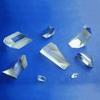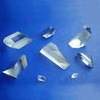- Contact Person : Mr. Lee John
- Company Name : Trust O&E Instruments (Suzhou) Co., Ltd.
- Tel : 86-512-68080407
- Fax : 86-512-68080511
- Address : Jiangsu,Suzhou,No.1 Yushan Road, New Development District
- Country/Region : China
- Zip : 215011
Schmidt-Pechan prism
Detailed Product Description
Schmit-Pechan prism
A Schmidt-Pechan prism is a type of used to rotate an image by . They are commonly used in as an image erecting system. Compared to binoculars using a or a binoculars using a Schmidt-Pechan roof prism is more compact.
[] Method of OperationThe Schmidt-Pechan prism is a merger of the designs of the and the .
The Pechan prism is a composite of two prisms separated by an air gap. It will invert or revert (flip) the image depending up orientation of the prism but not both at the same time. By replacing the second prism in the Pechan design with a Schmidt prism the Schmidt-Pechan prism can both invert and revert the image and so act as an image rotator.
The Schmidt-Pechan prism consists of two glass prisms separated by an air-gap. The second, Schmidt, prism both reverts and inverts the image but in doing so deviates the path by 45°. The first prism corrects for this delivering a beam at 45° into the Schmidt prism. The design of the first prism is such that the entrance beam and exit beam are coaxial i.e. the Schmidt-Pechan prism does not deviate the beam if centered on the optical axis.
The lower prism uses one followed by a reflection from a mirrored surface to direct the beam into the second Schmidt prism so the orientation of the image is not changed.
The upper prism inverts the image by three total internal reflections in the vertical plane through the roof ridge. The "" section of the Schmidt prism flips (reverts) the image laterally with two total internal reflections in the horizontal plane from the roof surface: once on each side of the roof. This latter pair of reflections can be considered as one reflection in the vertical plane. Both inversion and reversion together cause a 180° rotation of the image. The image's is not changed.
The reflection from the bottom surface of the first prism is not by total internal reflection since the light is incident at an angle less than the . This is unlike other roof prisms like the . This surface of the Schmidt-Pechan prism requires a reflective coating for this prism to be usable in practice.
[] Problems with the Schmidt-Pechan prism[] Glassair transitionsAll of the entry and exit surfaces must be to minimize losses, though the type of coating has to be carefully chosen as the same faces of the prism act both as entry faces (desiring good anti-reflection coating) and internally reflective faces (require a coating maximizing reflection). A paper, "Progress in Binocular Design", by Konrad Siel at shows that single-layer anti-reflective coatings on these surfaces maximized image contrast.
[] Reflection lossesAs the light is incident at a glassair boundary with an angle less than the , does not occur at that surface.
To mitigate this problem, a mirror coating is used on those sufaces. Typically an aluminum mirror coating of 87% to 93%) or silver mirror coating (reflectivity of 95% to 98%) is used.
The transmission of the prism can be improved by using a dielectric coating rather than a metallic mirror coating. This causes the prism surfaces to act as a . The dielectric multilayer coating increases reflectivity from the prism surfaces by acting as a . A well-designed dielectric coating can provide a reflectivity of more than 99% across the visible light spectrum. This is much improved compared to either an aluminum or silver mirror coating and the performance of the Schmidt-Pechan prism is similar to the or the .
The requirement for a mirror coating makes the Schmidt-Pechan roof prism more lossy than the other image erectors using or that rely only on total internal reflections.
[] Phase correctionThe multiple internal reflections also cause a -dependent phase-lag of the transmitted light, in a manner similar to a . This must be suppressed by multilayer phase-correction coatings applied to one of the roof surfaces to avoid unwanted effects and a loss of contrast in the image.
In a roof prism without a phase correcting coating s-polarized and p-polarized light each acquire a different as they pass through the upper prism. When the two polarized components are recombined between the s-polarized and p-polarized light results in an different intensity distribution perpendicular to the roof edge as compared to that along the roof edge. This effect reduces contrast and resolution in the image perpendicular to the roof edge. Giving an inferior image compared to that from a porro prism erecting system. This roof edge diffraction effect may also be seen as a perpendicular to the roof edge generated by bright points in the image.
This effect can be seen in the elongation of the in the direction perpendicular crest of the roof as this is a from the discontinuity at the roof crest.
The unwanted interference effects are suppressed by a special known as a phase-compensating coating on the roof surfaces of the roof prism. This coating corrects for the difference in geometric phase between s- and p-polarized light so both have effectively the same phase shift and no interference degrades the image.











